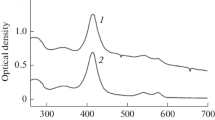Abstract
The active principle of horse red blood cell haemolysate enhancing sulphonamide activityin vitro (HC factor) was partially purified by adsorption to DEAE-cellulose and subsequent fractionated elution. The properties of the factor, as disclosed so far, suggest that it may be a protein-containing substance of a rather high molecular weight. The HC factor counteracts the sulphonamide-antagonizing property of meat-extract, but not of peptone, of enzymic casein hydrolysate and of some known sulphonamide antagonists.
Similar content being viewed by others
References
Adams E., Smith E. L.: Peptidases of erythrocytes II. Isolation and properties of prolidase.J. Biol. Chem. 198, 671 (1952).
Andrews P.: See Pharmacia prospectus: Sephadex gel filtration in theory and practice. Uppsala, 1966.
Bigger J. W., Ware G. C.: Potentiation of sulphonamide by “L-substance”.Lancet II, 427 (1950).
Böhni E.: Vergleichende bakteriologische Untersuchungen mit der Kombination Trimethoprim/Sulfamethoxazolin vitro undin vivo.Chemotherapy 14 Suppl: 1 (1969).
Bushby S. R. M.: Combined antibacterial actionin vitro of trimethoprim and sulphonamides.Postgrad. Med. J. 45 Suppl: 10 (1969).
Bushby S. R. M., Hitchings G. H.: Trimethoprim, a sulphonamide potentiator.Br. J. Pharmac. Chemother. 33, 72 (1968).
Chabbert Y., Boyer F., Dechavassine M.: Determination de la sensibilité microbienne aux sulfamides par une méthode de disques sèchés.Ann. Inst. Pasteur 85, 56 (1953).
Colebrook L., Francis A. E.: Varying sensitivity of haemolytic streptococci to the sulphonamides.J. Path. Bact. 53, 155 (1941).
Drabkin D. L.: The crystallographic and optical properties of the haemoglobin of man in comparison with those of other species.J. Biol. Chem. 164, 703 (1946).
Harper G. J., Cawston W. C.:In vitro determination of the sulphonamide sensitivity of bacteria.J. Path. Bact. 57, 59 (1945).
Haut A., Cartwright G. E., Wintrobe M. M.: Electrophoresis of nonhaemoglobin proteins from concentrated haemoglobin-free hemolysates.J. Lab. Clin. Med. 63, 279 (1964).
Huennekens F. M. et al.: Erythrocyte metabolism IV. Isolation and properties of methemoglobin reductase.J. Biol. Chem. 227, 261 (1957).
Kanitz A.: Chemie der Blutkörper, p. 560, in Oppenheimer:Handbuch der Biochemie des Menschens und der Tiere, Vol.II, 1925.
Keilin D., Hartree E. F.: The combination between methaemoglobin and peroxides: H2O2 and ethylhydroperoxide.Proc. Roy. Soc. Ser. B 117, 1 (1935).
Keilin D., Mann T.: Carbonic anhydrase. Purification and nature of the enzyme.Bioch. J. 34, 1163 (1940).
Kutzsche A.: Die Bedeutung derin vitro-Teste für die klinische Prüfung von Chemotherapeutica.Antib. Chemother. Fortschr., Basel12, 315 (1964).
Lund E.: Sensitivity testing with sulphonamide preparations.Acta Path. Microbiol. Scand. 36, 431 (1955).
McLeod J. W., Mayr-Harting A., Walker N.: The influence of access of free O2 on the action of antiseptics with special reference to the sulphonamides.J. Path. Bact. 56, 631 (1944).
Sahyun M. et al.: Growth stimulating factors for microorganisms.J. Inf. Dis. 58, 28 (1936).
Walker N. et al.: Observations on the prevention of bacterial growth by sulphonamides with special reference to the Harper and Cawston effect.J. Path. Bact. 59, 631 (1947).
Waterworth P. M.: Practical aspects of testing sensitivity to trimethoprim and sulphonamide.Postgrad. Med. J. 45, Suppl.: 21 (1969).
Author information
Authors and Affiliations
Additional information
Part of this work was presented at the Vth Int. Congress of Chemotherapy, Vienna, 1967, by the first author.
Rights and permissions
About this article
Cite this article
Gláz, E.T., Machay, T. Horse erythrocyte factor enhancing sulphonamide activity. Folia Microbiol 17, 88–94 (1972). https://doi.org/10.1007/BF02877905
Received:
Issue Date:
DOI: https://doi.org/10.1007/BF02877905




